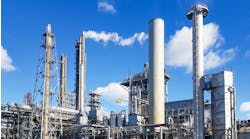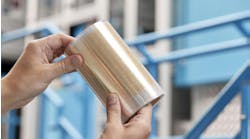THIS MONTH’S PUZZLER
Our evaporation train was running perfectly. Then, the internals suffered corrosion and corporate engineering decided to replace the type-304 stainless-steel calandria with one made of type-316L. They also expanded the capacity of the system and installed a radial-flow recompression compressor in the last evaporator of the four-evaporator unit (see figure). The compressor recovers steam, which is blended with make-up.
That’s when our nightmare began. Solids contaminate steam captured by the compressor. The separator appears to be undersized. After only two years, we are seeing stress corrosion cracking (SCC) in the calandria and even in the shaft and impeller of the compressor.
I’m wondering if we should dig deeper, perhaps look at the steam composition. One engineer suggested treating the steel in the calandria to protect it. Another suspects chlorine SCC but can’t find the source; he says we should replace the whole evaporation system with one made of a nickel alloy. An inspection of the compressor seal oil pump reservoir found burnt product, rust and water. A compressor expert corporate hired wants to improve the separation. Any ideas? I’m out of options. Without the recompression compressor, we push our boilers to the limit in running this evaporation train.
First Tune The Process
You should consider five points:
1. Stress corrosion cracking (SCC), as the name suggests, is caused by stress, corrosive medium, and metallurgy. It starts with pitting and micro-cracks. Broadly put, if you can control these factors, you can increase the threshold for SCC. Austenitic steels, including 316 (0.08% C) and 316L (0.03% C), are susceptible to SCC. The lower carbon content of 316L relative to 316 offers better protection against carbon precipitation during welding. Although SCC starts with pitting or micro cracks, it is hard to predict or monitor. So:
• Check the operating temperatures, pH, and composition of feed to the crystallizers — especially H2S and chloride content, because H2S and chlorides have been identified as two key species causing SCC. Typically, below 140°F, chlorides are less aggressive than at higher temperatures. Upsets in upstream equipment might have increased concentrations of these species beyond their threshold values. The key is to keep concentrations and temperatures below their threshold values.
• Contact the equipment vendor to get help in terms of threshold concentrations of H2S and CO2, temperatures and pH to reduce SCC. In addition, check “Materials for Use in H2S-containing Environments in Oil and Gas Production”(NACE MR0175/ISO 15156 standard from the Association of Materials Performance & Protection, the successor to NACE) for threshold concentrations of these species.
• While stress annealing can remove residual stresses from welding, this approach is not effective for austenitic steels. Alternatives are shot peening near weld areas or grit blasting. Because these operations need careful control to avoid creating stresses at other locations, you should get help from your vendor’s corrosion experts and develop detailed procedures for these operations.
• Suitable coatings can help by keeping the corrosive environment isolated from the metal and weld areas. Here again, the equipment vendor could offer help.
• In the long run (unfortunately, this is no help for now), review your material selection process. Austenitic steels (304, 304L, 316, 316L) have lower SCC thresholds than those of duplex, ferritic steels such as 430, 444 or stainless steels with higher Ni content (e.g., >25%). Consider alloys such as 439, 444, duplex, super duplex, or high nickel (above 25%). In the selection process, keep in mind the ranges in composition, pressure, temperature, and pH variations of crystallizers/calandrias, as well as welding/fabrication requirements.
2. If the problem of carryover to the compressor is intermittent, it possibly could stem from operational upsets or mechanical breakage of internals. Check data logs or the historian for abrupt changes in flows or levels in the separator and last stages of the crystallizers.
3. Check the demister pad in the separator. To do this online may call for x-ray analysis. Also, check the pressure differential across the separator. Too-low pressure drop could indicate a missing, broken or mis-installed demister pad. On the other hand, too-high pressure drop causes a higher vapor velocity and carryover.
4. Phase separators are designed using the Souders-Brown equation, which has gas velocity (superficial velocity) as a function of liquid density and the density difference between gas and liquid phases. Check your current operation against empirical charts that show vapor-handling capacity of different-sized separators as a function of pressure. Operating gas flows above the design values obviously means the separator is under-designed. On the other hand, if operating flows are below the design capacity values, then other problem areas exist.
5. Burnt product and rust (black deposits) in the compressor seal oil probably result from liquid accumulation near the weld areas of the calandrias. Depending on the seal construction, water in the seal fluid could indicate seal failure (water/vapor condensation) or water leakage into the fluid system. In addition to SCC, you also may have general corrosion elsewhere in the system, which could be carried over to the separator and compressor.
GC Shah, consultant
Houston
Protect Against Chlorine-SCC
The corrosion problem is system-wide. It started long before the compressor was added but the production increase may have made it worse.
This looks like a classic engineering dilemma: you suspect a cause (chlorine stress corrosion cracking, Cl-SCC) but don’t have the time or money to collect and evaluate the proof needed to provide the scientific basis that corporate management demands to spend millions of dollars. (I’ve suffered this frustration myself.) Fortunately, a few solutions won’t cost millions.
Look at protection of the bearings and seals from corrosion and contamination — that’s a cheap fix. Sure, the compressor still will eventually fail from corrosion but at least not catastrophically.
Now, let’s consider the more-expensive solutions.
Spending money on a slightly better austenitic stainless steel (316L) didn’t help, which is another clue about Cl-SCC. One option might be nickel cladding. Another could be a material like titanium or a nickel-iron alloy. Titanium generally is less expensive than a comparable nickel alloy. However, it may not have adequate mechanical properties, e.g., for compressor shafts and rotors, but may do fine as a tank wall. The cost of titanium is about 35 times that of stainless steel, so cladding may be the better option; cladding will work for compressor blades but probably not for shafts. The best solution for shafts may be a nickel cladding. Some treatment methods exist to desensitize austenitic steels but they suffer from the same problem as cladding — scratching can undermine them; at least you can make cladding thicker than a couple of molecules.
The solids in the compressor are a big red flag. From the figure, it looks like the separator is a chevron type, which is grossly inadequate for the job you’re intending to do. The description says the production rate increased; this means there is less free-board in the evaporators, allowing more carry-over. The solution is two-pronged: First, check the design calculations with the evaporator manufacturer. (Never assume the project engineer did this!) Then, replace the separator with a gas/liquid/solid separation membrane, the multi-million-dollar solution.
While you’re doing this, inspect all the evaporators thoroughly for Cl-SCC and take samples for metallurgical analysis. On the side, perhaps you can develop better systems to protect the compressor oil and seals from damage. It’s worth noting that oil system failure is the leading cause of compressor fires.
Don’t limit your review with the evaporator manufacturer to the last evaporator. Look at the entire evaporator train. Review product changes with quality control. Double check for other changes to the system, feedstock, utilities, controls and even personnel since the implementation of the production increase.
Alternatively, given the costs and complications in preventing damage from Cl-SCC, maybe it might be cheaper to eliminate chlorine from your fresh water source.
Dirk Willard, consultant,
Wooster, Ohio
May’s Puzzler
Our plant’s old heat exchanger is showing its years. It’s a shell-and-tube exchanger with two passes for the tubes and one pass for the shell. A sticky product with a viscosity of 120 cP at 280°F and 80 cP at 150°F goes through the tubes. The density is 0.88 and 0.84, respectively, and the mass heat capacity is 0.82, and 0.9. I estimate a thermal conductivity of about 0.025 BTU/hr-ft-°F at about 100°F. Semi-saturated steam at 150 psig goes through the shell.
In the past three months, operators have noticed burnt product. Looking at the valve performance from trends, the steam valve seems to swing open more quickly and tries to throttle quickly down. Maintenance blames routine fouling. The next outage is due in six months. So, the manager says to run the product a little cooler going into the exchanger. The process engineer warns the pump can’t handle that. The production manager complains the steam traps aren’t being replaced when they stick open.
I’m not convinced by any of these arguments. The traps are working. While the pressure drop across the tubes is higher than before, we don’t have a good flow meter on the product so there’s no way to know what normal is.
What do you think is causing the problem? How should I approach my investigation? Is there a way to limp through until the next scheduled outage?
Send us your comments, suggestions or solutions for this question by April 8, 2022. We’ll include as many of them as possible in the May 2022 issue and all on ChemicalProcessing.com. Send visuals — a sketch is fine. E-mail us at [email protected] or mail to Process Puzzler, Chemical Processing, 1501 E. Woodfield Rd., Suite 400N, Schaumburg, IL 60173. Fax: (630) 467-1120. Please include your name, title, location and company affiliation in the response.
And, of course, if you have a process problem you’d like to pose to our readers, send it along and we’ll be pleased to consider it for publication.

